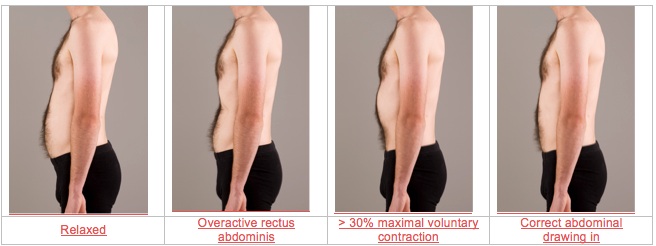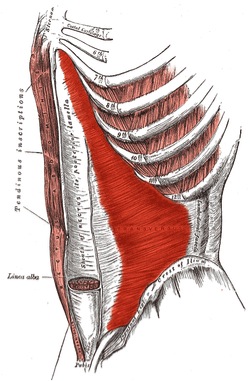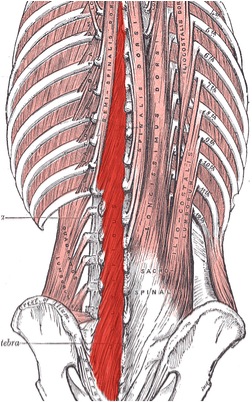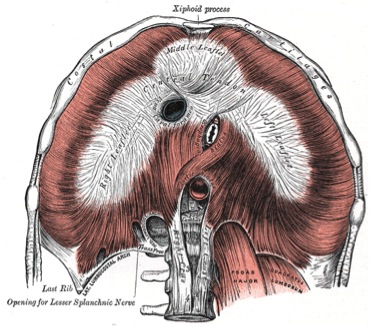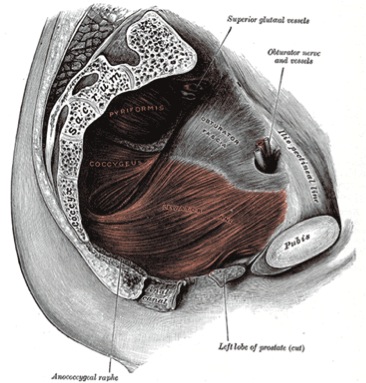Core Stability
Original Editor - Sem Bras
Top Contributors - Sheik Abdul Khadir, Katherine Knight, Lucinda hampton, Khloud Shreif, George Prudden, Sem Bras, Vanessa Rhule, Admin, WikiSysop, Yagdutt Yagdutt, Kim Jackson, Venus Pagare and Wanda van Niekerk
Definition[edit | edit source]
Core stability The human lumbar spine without muscles and viscera collapses easily. To allow movement, carry loads and protect the spinal cord and nerve roots “stability” is required. Stability is provided in a co-ordinated manner by the active (eg muscles), passive (eg lumbar spine) and control (eg neurological systems).Cite error: Invalid <ref> tag; name cannot be a simple integer. Use a descriptive title There is controversy and some confusion on the definition of the term “core stability”. Cite error: Invalid <ref> tag; name cannot be a simple integer. Use a descriptive titleCite error: Invalid <ref> tag; name cannot be a simple integer. Use a descriptive titleCite error: Invalid <ref> tag; name cannot be a simple integer. Use a descriptive titleTraditionally this term has referred to the active component to the stabilizing system including deep/local muscles that provide segmental stability (eg transversus abdominis, lumbar multifidus) and/or the superficial/global muscles (eg rectus abdominis, erector spinae) that enable trunk movement/torque generation and also assist in stability in more physically demanding tasks.Cite error: Invalid <ref> tag; name cannot be a simple integer. Use a descriptive title Different proponents have advocated different types of core stability exercises ranging from the abdominal drawing in maneuver (Figure 1) to sit ups or “plank” type exercises (Figure 2).
Figure 1: Correct and incorrect abdominal drawing in
Figure 2: Plank on a medicine ball
Training the local muscles (developed by physiotherapists) is a complex skill for participant and trainer that requires precise and rigorous assessment, exercise instruction and feedback. Training the superficial muscles can be equally complex and is undertaken by a range of health and sporting professionals with a large variety approaches evident.
An alternative term to “core stability” is “motor control” that reflects concepts around lumbar stability in a more holistic approach including: the brain, sensory inputs, motor outputs, mechanical properties of muscles/joints, what is normal/abnormal and what may be adaptive/maladaptive.Cite error: Invalid <ref> tag; name cannot be a simple integer. Use a descriptive title
Clinically relevant anatomy
[edit | edit source]
Local muscles The local/deep muscles have their origin or insertion on the lumbar vertebra therefore can exert a segmental stabilizing/stiffening effect.Cite error: Invalid <ref> tag; name cannot be a simple integer. Use a descriptive title Standard texts provide detailed information on anatomyCite error: Invalid <ref> tag; name cannot be a simple integer. Use a descriptive titleCite error: Invalid <ref> tag; name cannot be a simple integer. Use a descriptive title on key deep muscles and online resources are also available (see Figures 3-6).
Figure 1: Transversus abdominis (from http://en.wikipedia.org/wiki/Transversus_abdominis)
Figure 2: Lumbar multifidus on the left of the spine (from http://en.wikipedia.org/wiki/Multifidus)
Figure 3: Inferior view of the diaphragm (from http://en.wikipedia.org/wiki/Thoracic_diaphragm)
Figure 4: A medial view of the left pelvic floor (from http://en.wikipedia.org/wiki/Pelvic_floor)
The mechanisms of the deep muscles and stability/stiffness are controversial but transverse abdominus may act like a canister with the diaphragm and pelvic floor muscles. This co-contraction increases the intra-abdominal pressure, which creates an extension moment at the spine and has been hypothesized as increasing stability/stiffness in particular via connections with the thoraco-lumbar fascia.Cite error: Invalid <ref> tag; name cannot be a simple integer. Use a descriptive title The multifidus may increase the rotational segmental stability in a sagittal and horizontal plan.Cite error: Invalid <ref> tag; name cannot be a simple integer. Use a descriptive title
Normal function of the deep muscle system is impaired with back pain.Cite error: Invalid <ref> tag; name cannot be a simple integer. Use a descriptive title There is strong evidence supporting the effectiveness of treatment aimed at normalizing this function by way of “specific motor control training”/”specific muscle activation”.Cite error: Invalid <ref> tag; name cannot be a simple integer. Use a descriptive title
Global muscles
There are a wide range of superficial/global muscles that are large, cross multiple segments and do not attach directly to the vertebrae including rectus abdominis, external obliques and parts of the erector spinae. These muscles generate torque, act like guy ropes to control spinal orientation and work in co-contraction to control spinal motion in the application of external loads.
The anatomy of these muscles is easily accessible online or in standard texts.Cite error: Invalid <ref> tag; name cannot be a simple integer. Use a descriptive title
Identifying muscle dysfunction [1][edit | edit source]
Local / deep muscles
Assessment of muscle function of the local/deep muscles is analogous with providing treatment. An understanding of a normal response is required for the abdominal drawing in maneuver (transversus abdominis), isometric activation of multifidus, normal breathing (diaphragm) and pelvic floor activation. Clinical methods have been published in texts, Cite error: Invalid <ref> tag; name cannot be a simple integer. Use a descriptive title journals,Cite error: Invalid <ref> tag; name cannot be a simple integer. Use a descriptive title and online (http://www.physio-pedia.com/Lumbar_Motor_Control_Training). The use of diagnostic ultrasound can also be of value as an adjunct to clinical methods.
Global/superficial muscles
There is a wide range of tests for dysfunction of the global muscles regarding core stability/motor control. There are definitive texts on this topic Cite error: Invalid <ref> tag; name cannot be a simple integer. Use a descriptive title as well as specific tests listed below:[5]
- Prone instability test
- Prone extension endurance test (Biering-Sorenson paraspinal endurance strength)
- Side bridge endurance test (quadratus lumborum endurance strength)
- Pelvic bridging
- Leg lowering test (lower abdominal strength)
- Trunk curl
- Hip external rotation strength
- Modified Trendelenburg test (single leg squat with observation in frontal plane)
- Single leg squat in sagittal plane
- Single leg squat in transverse plane
These tests for local and global muscle function should be applied and interpreted using clinical reasoning principles within a broad understanding of normal/abnormal motor control. There is preliminary evidence for a clinical prediction rule identifying people with low back problems more likely to respond to specific motor control/specific muscle activation of the local muscles Cite error: Invalid <ref> tag; name cannot be a simple integer. Use a descriptive title:
- Younger age (<40)
- Greater general flexibility (hamstring length greater than 90°, postpartum)
- Positive prone instability test
- Presence of aberrant movement during spinal range of motion (painful arc of motion, abnormal lumbopelvic rhythm, and using arms on thighs for support)
Management principles
[edit | edit source]
Here are som examples of exercises to improve the motor control / core stability of the lumbar spine.
Local / deep muscles
Clinical methods have been published in texts, Cite error: Invalid <ref> tag; name cannot be a simple integer. Use a descriptive title journals,Cite error: Invalid <ref> tag; name cannot be a simple integer. Use a descriptive title and online (http://www.physio-pedia.com/Lumbar_Motor_Control_Training. Practitioners treating people with significant pathology where local muscle dysfunction is likely should retrain specific motor control before moving onto more global training.Cite error: Invalid <ref> tag; name cannot be a simple integer. Use a descriptive title
Global / superficial muscles
It is important for practitioners/sports personnel attempting to global/superficial muscle function and strength to have a clear understanding of any pathoanatomical problems that may be positively or negatively affected by such exercise. Ideally all of these exercises should be done with correct lumbo-pelvic posture and control of the local/deep muscles. With most of these exercises duration of hold and repetitions can be varied (depending on the aim of the retraining/strength program) provided the exercise is done with good control.
- Crunches- Lie supine on the floor with your knees bent, arms crossed over your chest and the feet flat on the floor. Then lift your schoulders from the ground and curl you stomach. Avoid a full sit up and ensure the low back remains in contact with the floor.
- Obliques crunches - As per a normal crunch but leading with one shoulder towards the opposite knee (alternate sides each repetition).
- Plank - Lie prone on the floor. Then while keeping your whole trunk straight (like a plank) lift up onto your forarms, with the elbows right under the shoulders, and toes. Hold this position as long as possible with control. To make the exercise more difficult try to lift one leg slightly of the ground. Balls/balance devices can also be used under the arms or feet. The plank can also be done on your side while supported by your feet and your forearm with your shoulder above your elbow.
- Bridges - Lie supine with your knees bent and the feet flat on the floor. Lift your pelvis of the ground while supporting on your feet and shoulders. The bridge can be progressed by lifting one foot off the ground end extending the knee.
- Hamstring raises - Balance on you hands and knees with your back flat and your arms/thighs perpendicular to the floor. Raise one leg behind you until it is horizontal. Alternate.
- Superman – As per a hamstring raise but progress by lifting the opposite arm to a horizontal position at the same time. Alternate.
- Leg raises - Lie on your back with your legs straight and your arms by your sides. Then lift one leg 4 inches of the ground. Your back has to stay flat on the floor. Don’t allow it to arch. Alternate. The exercise can be progressed by lifting both legs at the same time
- Hundreds - Lie on your back with your legs straight and your arms by your sides. Then lift both legs so that they form a right angle in the hip and knees. Lift your arm straight a few inches off the ground. Then simpli tap the ground 100 times. Focus on keeping your hips and legs completely still and your back flat.
- Leg extensions - Lie on your back with your legs straight and your arms by your sides. Then keeping the knee straight lift one leg until the foot is 4 inches off the ground. Alternate
There are also multiple exercises that can be performed with a physioball. The exersises where proven to have a greater gain of torso balance and neuronal activity then regular floor exercises.[2] Akuthota et al gave an example of how to build up a program with these exercices [1]
- Go over anatomy of the core
- Active participation emphasized
- Local/deep muscle activation – progress once able to perform 30 reps with 8 sec hold)
- Abdominal bracing
- Bracing with heel slides
- Bracing with leg lifts
- Bracing with bridging
- Bracing in standing
- Bracing with standing row
- Bracing with walking Paraspinals/multifidis (advance if able to perform 30 reps with 8 s hold)
- Quadruped arm lifts with bracing
- Quadruped leg lifts with bracing
- Quadruped alternate arm and legs lifts with bracing
- Quadratus lumborum and obliques (advance if able to perform 30 reps with 8 s hold)
- Side plank with knees flexed
- Side plank with knees extended
- Trunk curl Facilitation techniques if necessary (pelvic floor contraction, visualization,palpation, identifying substitution patterns like pelvic tilt, ultrasound)
- Functional training positions with activation of core
Summary
[edit | edit source]
There is no single muscle or single exercise for low back problems and motor control/core stability as a treatment. At a minimum practitioners/sports personnel should be aware of key concepts in motor control and exercise and follow an evidence-based approach to exercise prescription.
Currently there is strong evidence for specific motor control/specific muscle activation in isolation, progressing to more global and functional exercises.
Peer reviewed by Jon Ford
Recent Related Research (from Pubmed)[edit | edit source]
References
[edit | edit source]
- ↑ 1.0 1.1 Akuthota V. et al, Core Stability Exercise Principles, spine conditions, 2008. (level of evidence A1)
- ↑ LUDMILA M. COSIO-LIMA, KATY L. REYNOLDS, CHRISTA WINTER,fckLRVINCENT PAOLONE, AND MARGARET T. JONES. Effects of Physioball and Conventional FloorfckLRExercises on Early Phase Adaptations in Back and Abdominal Core Stability and Balance in Women. Journal of Strength and Conditioning Research, 2003, 17(4), 721–725 (level of evidence B)
1. Panjabi, M., The stabilizing system of the spine: Part I: Function, dysfucntion, adaptation and enhancement. Journal of Spinal Disorders, 1992. 5: p. 383-389.
2. McNeill, W., Core stability is a subset of motor control. J Bodyw Mov Ther, 2010. 14(1): p. 80-3.
3. McGill, S.M., Low back disorders: Evidence-based prevention and rehabilitation 2nd ed. 2008, Illinois: Human Kinetics Publishers.
4. Hodges, P., Spinal control: the rehabilitation of back pain. 1st ed. 2013, Edinburgh: Churchill Livingston.
5. Urquhart, D., et al., Abdominal muscle recruitment during a range of voluntary exercises. Manual Therapy, 2005. 10: p. 144-153.
6. Richardson, C., G. Jull, and P. Hodges, Therapeutic exercise for lumbopelvic stabilisation: a motor control approach for the treatment and prevention of low back pain. 2004, Edinburgh: Churchill Livingstone.
7. Bogduk, N., Clinical and radiological anatomy of the lumbar spine. 5th ed. 2012, New York: Churchill Livingstone.
8. Bystrom, M.G., E. Rasmussen-Barr, and W.J. Grooten, Motor control exercises reduces pain and disability in chronic and recurrent low back pain: a meta-analysis. Spine (Phila Pa 1976), 2013. 38(6): p. E350-8.
9. Ford, J.J., et al., A classification and treatment protocol for low back disorders. Part 3: functional restoration for intervertebral disc related disorders. Phys Ther Rev, 2012. 17(1): p. 55-75.
10. Sahrmann, S., Diagnosis and treatment of movement impairment syndromes. 1st ed. 2002, St Louis: Mosby Inc.
